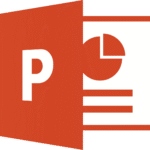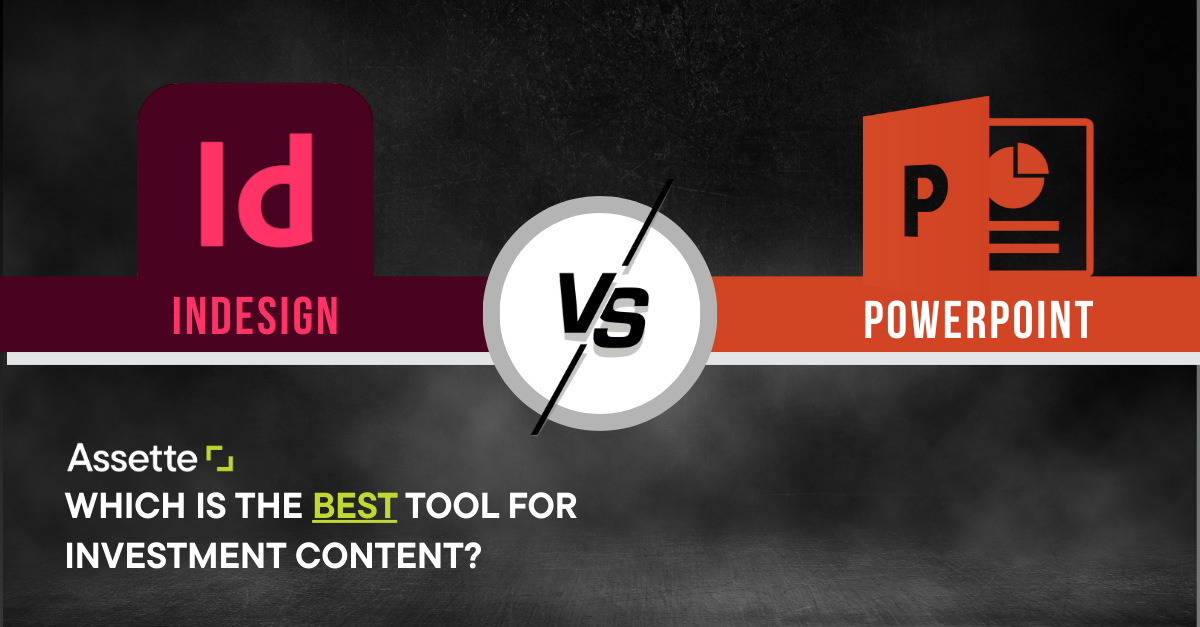When investment firms produce client-facing materials — fact sheets, quarterly reports, client presentations — two design tools often come up: Adobe InDesign and Microsoft PowerPoint.
Sure, they’re both professional design tools. But one was built for publishing, the other for business communication. The real question for investment marketers isn’t which tool is more powerful in theory — it’s which capabilities actually matter for fact sheets, client reports, and sales materials.
Comparing Design Capabilities
| Design Capability |  |  | Necessary for Investment Firms? |
|---|---|---|---|
| Object placement & layout precision | ✅ Ultra-fine, point-level control (1/72″) | ✅ Professional-grade alignment, grid & guide tools | ✅ Yes |
| Typography control | ✅ Advanced kerning, glyph alternates, optical margin alignment | ✅ Robust since Office 2016+, supports brand fonts | ✅ Yes |
| Prepress & Commercial Printing | ✅ CMYK separations, spot colors, bleed/slug, overprint preview | ❌ Standard RGB/PDF export | ❌ No |
| Interactive digital publishing | ✅ Build EPUBs, interactive PDFs with multimedia | ❌ Not supported | ❌ No |
| Image & graphic handling | ✅ Advanced manipulation | ✅ Cropping, masks, easy imports | ✅ Yes |
| Charting & data visualization | ❌ Requires Illustrator/Excel integration | ✅ Native Excel charts and data links | ✅ Yes |
| File accessibility & collaboration | ❌ Specialist designers only | ✅ Ubiquitous — anyone can edit | ✅ Yes |
| Compliance/governance controls | ❌ Manual process | ✅ Template locking, automation possible | ✅ Yes |
| Integration with business tools | ❌ Minimal | ✅ Deep Office/Teams/Excel integration | ✅ Yes |
Where InDesign Excels
To be fair, InDesign is excellent software. For certain industries, it’s unmatched.
- Book and magazine publishing: multi-chapter layouts, cross-references, and indexes.
- Commercial print: CMYK separations, bleed and slug controls, and prepress output.
- Interactive publishing: EPUBs, multimedia PDFs, and other digital formats.
- Ultra-fine typography: kerning pairs, glyph alternates, optical margin alignment.
These are powerful capabilities. But for investment firms focused on fact sheets, quarterly reports, and client materials, InDesign, which requires specialized training and a complete understanding of the entire Adobe Creative suite (including Illustrator for complex graphics, and Photoshop for image editing) to reach it’s full potential, tends to add cost and complexity without improving outcomes.
Where PowerPoint Excels
For the materials investment firms produce most often, PowerPoint offers everything needed:
- Charts and data visualization: seamless Excel integration.
- Collaboration: anyone in the firm can review and edit files.
- Speed: updates can be made quickly at quarter-end or during RFP crunch.
- Usability: no specialist skills or training required.
- Consistency: templates and brand controls ensure polished, compliant outputs.
In short: PowerPoint covers the capabilities that matter in investment marketing, without the overhead.
What Actually Matters for Investment Firms
The real decision point isn’t which tool has more advanced design features. It’s which tool aligns with the industry’s priorities:
- Timeliness — delivering client-ready materials quickly.
- Compliance — ensuring outputs are locked, consistent, and auditable.
- Scalability — enabling updates by more than just designers.
- Cost-efficiency — using tools already licensed by the firm.
- Utility – giving all team members the power to build and update materials.
- Professionalism – having the resources to produce professional, polished materials in-house.
On these measures, PowerPoint wins decisively.
Beyond Design: Extensibility and Automation
Even if you only considered design fidelity, PowerPoint is the smarter fit for investment marketing. But there’s an added advantage: extensibility.
Because it’s part of the Microsoft Office ecosystem, PowerPoint can integrate with automation to stream live data directly into templates. That eliminates manual updates, reduces compliance risk, and saves time. InDesign simply wasn’t built with that in mind.
Conclusion: The Right Tool for the Job
InDesign will always have its place in publishing and creative agencies. But for investment marketing, it’s complex, costly, and largely wasted — a tool where you’ll only ever use 15% of what you’re paying for.
PowerPoint delivers 100% of the capabilities that matter — at a fraction of the cost, in a platform your firm already owns. For fact sheets, reports, and client materials, it isn’t a fallback. It’s the professional, purpose-built choice.
For firms evaluating their options, the takeaway is clear: PowerPoint is the professional, purpose-built choice for investment marketing materials.
About Brian Ward
Brian E. Ward
Founder & Executive Creative Director, Emerson Ward Creative, LLC
Brian is the Founder and Executive Creative Director of Emerson Ward Creative, a boutique design and communications agency that works exclusively with traditional and alternative fund managers, and the broader investment management industry to help build their brands, expand their communications, and create impactful, effective websites, presentations and fund collateral. Brian brings over 20 years of industry experience to Emerson Ward, having worked in a wide range of marketing and branding roles in both traditional and alternative investment functions at HSBC, Wells Fargo, Ivy Funds and more. He has designed, built and managed hundreds of investor presentations and websites over the course of his career, and currently works with both startups and existing managers in the U.S. and abroad.
Brian is a graduate of Marist College in Poughkeepsie, NY, with a BS in Business Administration.
About Emerson Ward:
Emerson Ward is a boutique creative agency focused exclusively on providing custom, professional web, collateral, and content solutions to the asset management industry. We work with traditional and alternative asset managers, private equity groups, RIA’s, VCs and more, in both the US and abroad.



